When you think of world trees, you’re diving into some seriously profound symbols of inner growth. Take the Bodhi Tree, where Buddha found enlightenment, or Yggdrasil, the cosmic lifeline in Norse lore—both are epic in their own right! Then there’s the Banyan Tree, hanging strong with roots representing immortality. These trees connect deeply to cultures, reflecting personal evolution. Ready to explore more fascinating tree tales that shape our spiritual journeys? Buckle up, you’re in for a wild ride!
The Bodhi Tree: A Symbol of Enlightenment and Wisdom
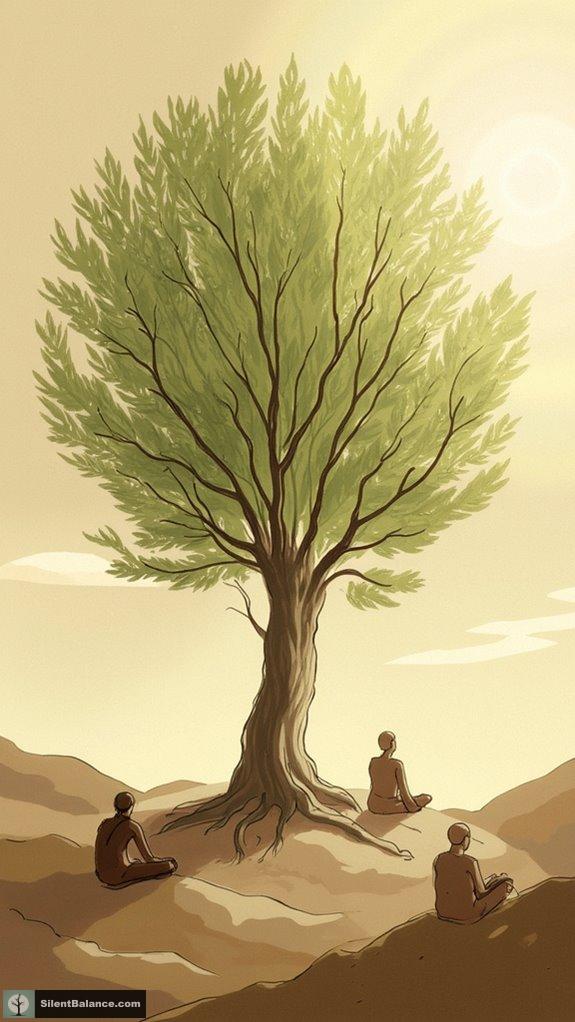
When you think about enlightenment and wisdom, the image of the Bodhi Tree probably pops to mind—a sacred fig tree where the Buddha achieved nirvana, right? This iconic tree isn’t just a pretty sight; it symbolizes the triumph over ignorance and suffering. Trees symbolize growth, enhancing our understanding of personal evolution.
The Bodhi Tree stands as a powerful symbol of enlightenment, marking the place where the Buddha found ultimate wisdom.
Envision sitting there for 49 days, facing distractions from that pesky demon, Mara. The dedication shines through, showcasing what true spiritual practice is about. And let’s not forget the countless pilgrims who visit Bodh Gaya, seeking inspiration! Each sapling and replica planted worldwide continues the legacy. The historical significance of Bodh Gaya as the site of the Buddha’s enlightenment connects to the myriad of experiences shared by seekers from all walks of life. Isn’t it fascinating how a tree can connect so many souls on their quest for growth?
Yggdrasil: The Cosmic Connector in Norse Mythology
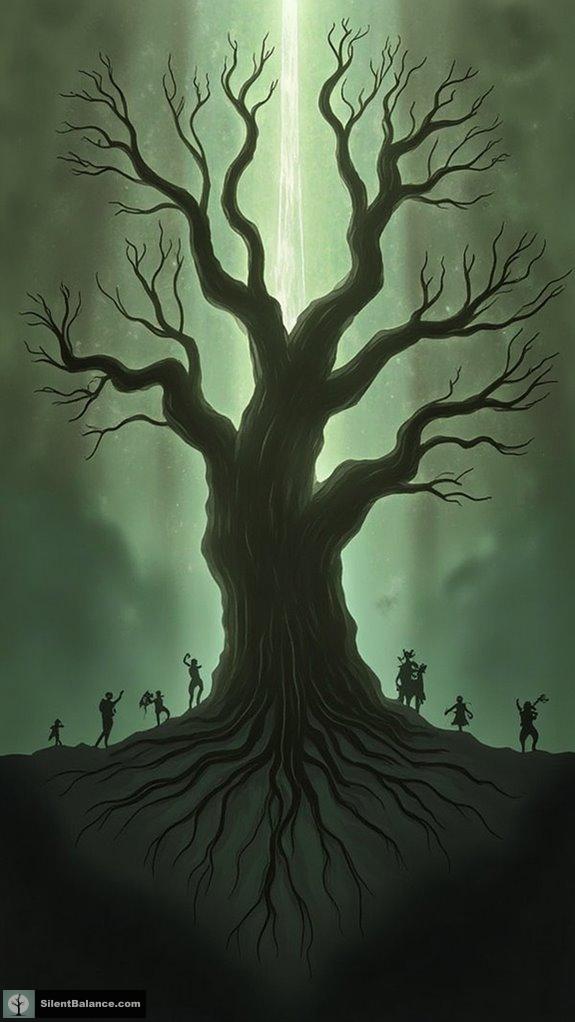
Yggdrasil isn’t just any tree; it’s the epicenter of Norse mythology, serving as the cosmic connector linking all areas of existence.
You’re talking about an immense ash tree with roots and branches grounding the Nine Worlds.
- An axis that binds domains
- An everlasting symbol of life
- Home to Norns, who govern fate
- Connects gods, giants, and humans
- Essentiality linked to cosmic balance
Think of Yggdrasil like the ultimate cosmic Wi-Fi—keeping everything connected, alive, and thriving in a complex universe. Additionally, its symbolism of interconnectivity emphasizes the profound relationships binding all worlds and creatures together.
The Oak Tree: Ancestral Strength and Spirituality

An oak tree isn’t just a tree; it’s like nature’s own monument to strength, wisdom, and resilience.
Ever felt the power of an ancient oak? Cultures worldwide hail it as a symbol of endurance, linking you to your roots.
Think of Zeus and the oracles—these trees whisper secrets that can guide you!
Ever connect with your divine nature in its shade? With longevity that stretches over a millennium, oaks remind us of growth and inner strength, urging you to speak your truth and embrace your durability. Oak trees symbolize protection and stability in times of trial, reminding us of the unwavering support that surrounds us.
The Banyan Tree: Immortality and Divine Presence in Hinduism
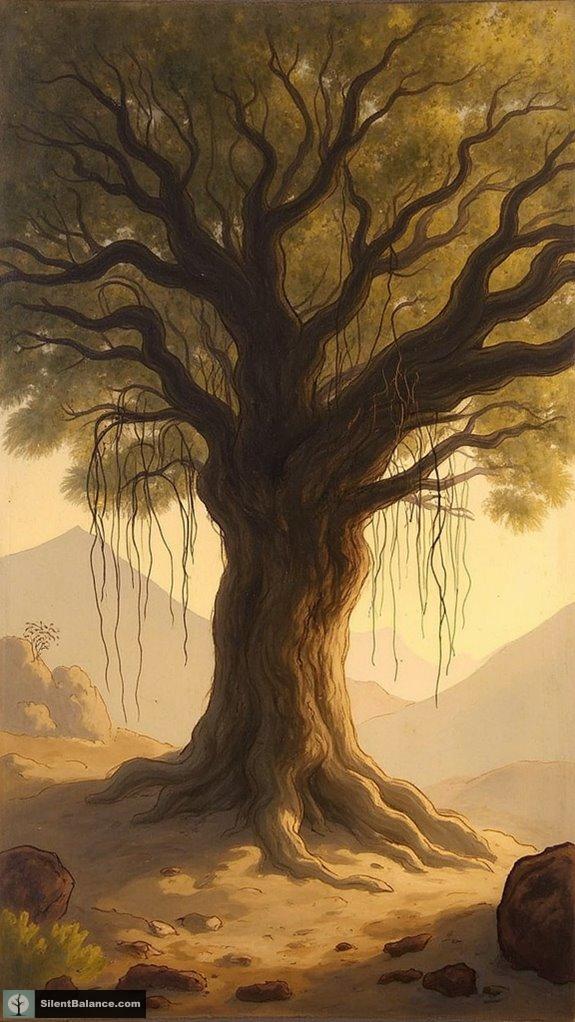
Beneath the sprawling canopy of the banyan tree, there’s a sense of magic that feels almost palpable, isn’t there?
This magnificent symbol of immortality and divine presence captivates hearts and minds in Hinduism.
- Represents creators: Brahma, Vishnu, and Shiva
- Aerial roots signify eternal life
- Linked to Yama, the god of death
- Focal point for prayers, community, and spiritual growth
- Revered as the Kalpavriksha, a wish-fulfilling tree.
Furthermore, the banyan tree exemplifies the interconnectedness of life, illustrating a profound lesson in unity and community found in various spiritual traditions.
The Baobab: Resilience and the Tree of Life in African Cultures
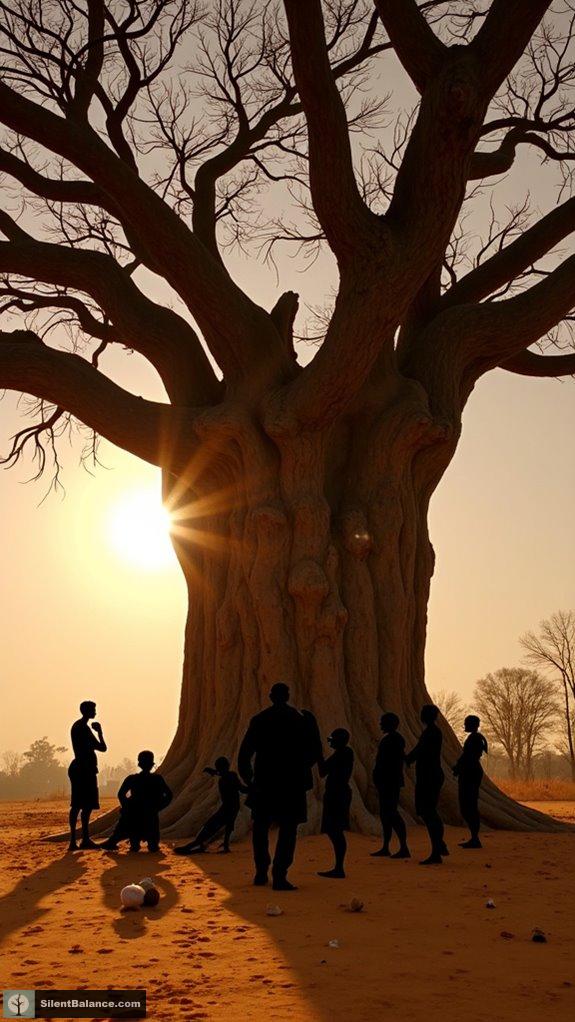
Considered the “Tree of Life,” the baobab holds a special place in the hearts of many African cultures, and it’s no wonder why. This remarkable tree symbolizes resilience, surviving harsh climates and thriving for over a thousand years. Envision its gnarled branches, famous for marking sacred spots, becoming gathering points for community tales and traditions. Have you tasted baobab fruit? Packed with vitamin C, it’s not just delicious but a superfood, too! From its medicinal leaves to its water-storing trunk, each part of the baobab serves a purpose, embodying a connection between ancestry, survival, and the vibrant spirit of African life. The symbolism of wood through the baobab illustrates the deep-rooted connection families have with nature and cultural heritage.
Tree Symbolism in Native American Traditions
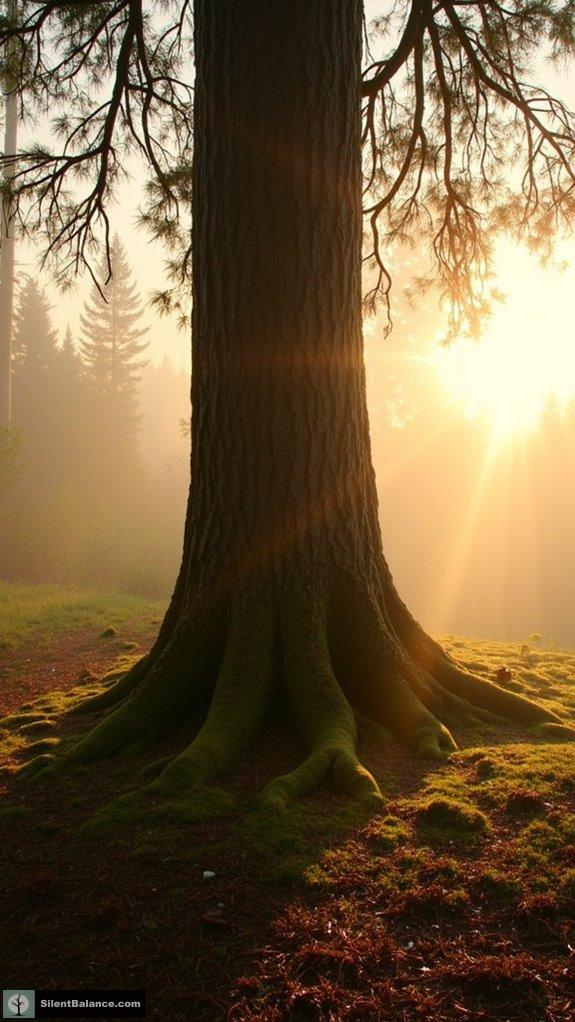
Trees in Native American traditions are more than just towering structures; they’re crucial elements of cultural identity and spiritual connectivity.
- Sacred embodiments of life and creation
- Pine trees symbolize longevity and harmony
- Major settings for spiritual ceremonies
- Essential for medicinal and nutritional practices
- Integral to tribal creation stories and teachings
Doesn’t it thrill you how these trees serve a higher purpose? They’re not just for climbing or shade; they’re symbols steeped in wisdom and respect. Cedar trees are particularly valued for their strength and protection qualities, representing resilience in various Native American cultures.
Each trunk and leaf tells a story, connecting generations. So, next time you pass a tree, think of the culture and spirit it embodies!
Trees as Archetypes in Jungian Psychology and Inner Growth
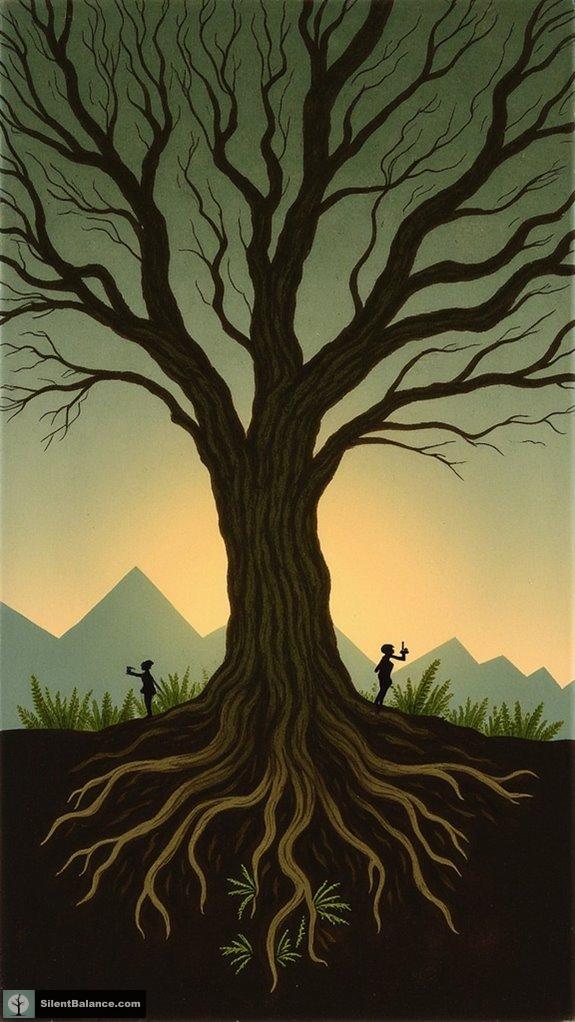
When you think about personal growth, it’s hard not to appreciate the depth of symbolism found in trees, especially through the lens of Jungian psychology.
Imagine the oak, standing strong, representing your inner self and the journey of individuation.
Think of roots delving deep into your unconscious, while branches stretch toward the light of consciousness.
Roots reaching deep into the unconscious nourish our growth, while branches reaching for the light embody our quest for self-discovery.
That tension between light and dark? It’s your shadow work, helping you acknowledge those repressed parts that crave expression.
Trees aren’t just wood and leaves; they’re cosmic bridges, inviting you to explore your mind’s universe and connect with your true essence.
These cultural tree myths often reflect our shared collective unconscious, reminding us that we are all part of a greater narrative.
Ready to grow?
World Tree Motifs Across Cultures
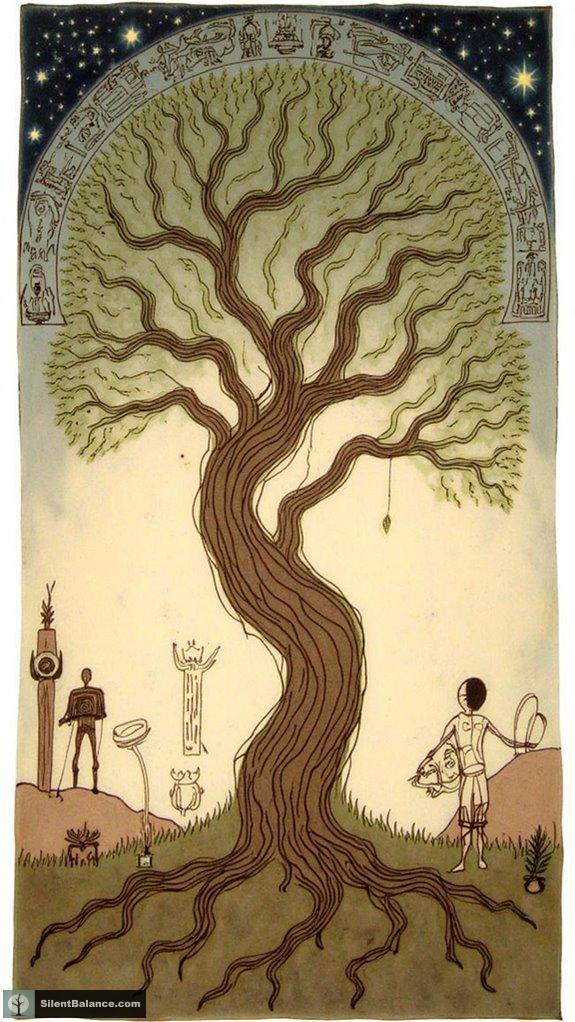
As you immerse yourself in the rich tapestry of global mythologies, you’ll discover a fascinating motif that pops up everywhere—the World Tree. This symbol connects cultures across the globe, reflecting shared narratives of life, death, and cosmic balance.
- Found in Indo-European and Native American myths.
- Central to Mongolic and Turkic storytelling.
- Present in the Korean Crown of Silla artifacts.
- Featured in Mayan lore as the cosmic axis.
- Chinese Fusang tree supports celestial patterns.
Isn’t it incredible how one tree’s roots can bridge continents and cultures? The World Tree isn’t merely a symbol; it’s a global heartbeat! This archetype also represents the concept of cosmic balance that resonates deeply in various traditions.
References
- https://www.wetmoretreecare.com/ftc-blog/the-cultural-significance-of-trees-around-the-world
- https://gardens.si.edu/learn/blog/trees-bridges-between-past-present-and-future/
- https://en.wikipedia.org/wiki/World_tree
- https://www.uef.org/lessons/article-cosmic-tree/
- https://www.betterplaceforests.com/blog/symbolism-of-trees/
- https://smarthistory.org/bodh-gaya-the-site-of-the-buddhas-enlightenment/
- https://dharmacrafts.com/blogs/news/bodhi-day
- https://www.buddhanet.net/e-learning/buddhism/pbs2_unit03/
- https://www.youtube.com/watch?v=zT6aj4DNTjs
- https://bodhgayaholiday.com/bodhi-tree/
- 7 Essential Tips for Selecting Outdoor Bonsai Tree Containers - September 6, 2025
- Perfect Pots for Thriving Tropical Bonsai Tree Containers - September 5, 2025
- Top 10 Bonsai Tree Designs for Miniature Home Greenery - September 5, 2025

